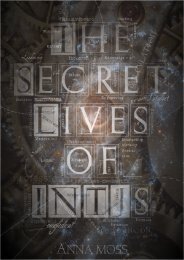Create successful ePaper yourself
Turn your PDF publications into a flip-book with our unique Google optimized e-Paper software.
their own type, they do project their own type's characteristics upon their heroes. 75 For example,<br />
suppose you have an ESTP hero. An INTJ notices moments of introversion or reflection, while an<br />
ENFJ notices moments of compassion or selflessness. Like the blind men and the elephant, each<br />
type particularly notices aspects of the hero that they most relate with.<br />
So when looking in the mirror of fiction, we must take care to be beguiled by our own preferences.<br />
I will give supporting evidence for most of the people I type in this book.<br />
On a side note: it appears that people seek out heroes of their own type more often than heroes of<br />
the opposite type. Out of the 196 heroes in the study, 52 (27%) had a personality matching the<br />
adolescent's own type, while just 3 (2%) were the exact opposite type. Roughly speaking then,<br />
people are something like 14x more likely to choose people of their own type as heroes than an<br />
opposite type.<br />
Fun fact: the majority of Rationals depicted in Saturday morning cartoons are genius villains who<br />
probe the mysteries of science and make brilliant breakthroughs in technology. These characters are<br />
perfect role models for NTs save for the minor shortcoming of being evil. “What's wrong with me?<br />
Why do I always like the villains?” Rationals wonder.<br />
Notes on Type Identifications<br />
Figuring out a fictional character or real life person's type can be an illuminating experience; it can<br />
also make one aware of just how inadequate type-based stereotypes are when describing actual<br />
human behavior. On several occasions I have found my pet theories disproven by a real life<br />
example and have been forced to rethink them in accordance with the new data. But this makes it<br />
doubly important to get a person's type right to begin with.<br />
Here are a few rules of thumb that can prevent errors:<br />
First and foremost, no single piece of evidence is EVER conclusive on its own. A common mistake<br />
is to fixate on a couple items of evidence and assign them a huge amount of weight, i.e., “All INTJs<br />
do this” or “Only INTJs can do this.” So for example, people will say, “An INTJ would never do<br />
that because they have too much self control.” Or “INTJs are the only impassive type; this person<br />
was described as impassive; therefore they can only be an INTJ.”<br />
There is an exception to every rule; in fact, INTJs cannot claim exclusivity on any characteristic<br />
that I know of. Even if INTJs are the type most likely to embody a particular trait, there are 2-3<br />
other types that also have the trait in abundance and could plausibly be described as possessing it.<br />
Then too, one must always look for explanations other than type for a behavior. An extravert who<br />
avoids people because he has been teased and bullied by his peers is not an introvert, despite<br />
outward appearances. A perceiver's job may require them to be more organized than they would<br />
naturally prefer.<br />
Finally, one must allow for individual variation. Some INTJs are very clear in their type; others<br />
have moderate preferences. Any particular INTJs may be very close to being an INFJ, ENTJ, INTP,<br />
ISTJ, etc. Never mistake a type’s average characteristics for a rule that always applies to everyone<br />
of the type. An average is simply something that usually applies to most.<br />
Therefore one must not give in to the temptation of simplistic certainty. It is only when the<br />
preponderance of dozens of pieces of weak, good, and even excellent evidence begins to point<br />
towards a single type that an identification can be made.<br />
75 Petersen, 1993




